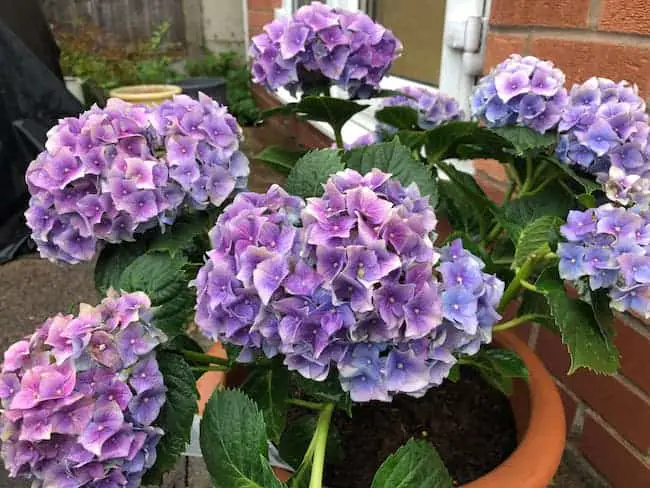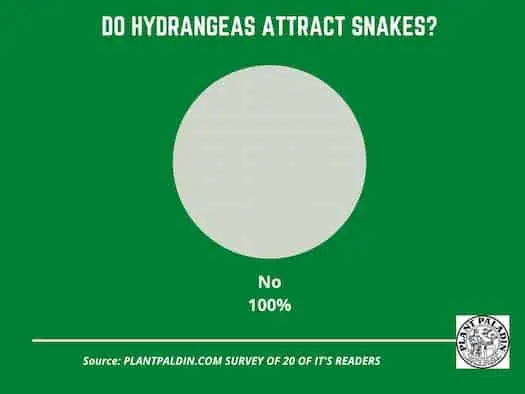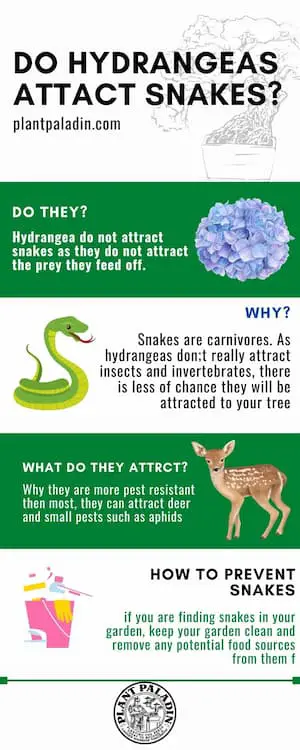This website is supported by its readers. If you click one of my links I may earn a commission. I am also a participant in the Amazon affiliates program and I will also earn a commission from qualified purchases.

So recently, I purchased a bunch of beautiful blue hydrangeas to spruce up and add to my flower and plant collection. That said, one of the questions I always have before buying new plants for my backyard is if it attracts wildlife. Naturally, my brain got racing, and with the increase in snake bites, the question I have on my lips is, do hydrangea attract snakes?
Hydrangea does not attract snakes. This is because the tree is notorious for repelling reptiles and small mammals like snakes and mice and being pest resistant to insects and invertebrates that snakes might eat.
So what is the science behind why hydrangeas don’t attract snakes? And what plants attract snakes? Keep reading to find out more!
Does hydrangea attract snakes?
To get to the bottom of if hydrangea attracts snakes, I started growing my hydrangea, visited my local botanical gardens, spoke with my local gardener, and even got in touch with 20 plant paladin readers from around the world who also keep hydrangea to ask them this very question.
To summarise:
- Hydrangea does not attract snakes in their native climates or when grown in backyard/garden spaces.
- These flowers and sub-species, such as mophead hydrangeas in particular, do not produce nectar to attract bees, and due to the lack of bees and other insects, snakes who tend to prey on them will not be attracted to your tree.
- On top of this, all snakes are carnivores meaning that snakes will never be attracted to your hydrangeas as a food source.
- While other hydrangeas do have small amounts of pollen, such as hydrangea Panicular for the most part, their flowers are sterile, which will naturally fend off insects that attract snakes.
- While hydrangea does not attract snakes, it will still attract some small insects common with plant species. These include Aphids, Whiteflies, Spider-mites, and other common pests.
- You may find snakes near hydrangea in their native environment of East Asia when grown in large fields; however, this will usually be purely due to the correlation of them living in the same space instead of being directly caused by them.
Why doesn’t hydrangea attract snakes?
So now we know that hydrangea doesn’t attract snakes; what is the scientific reason behind this?
While there are no specific scientific studies on the reason, it all comes down to food.
Snakes are carnivorous, with larger snakes preying on rodents and small mammals such as rabbits and smaller snakes eating insects and invertebrates.
As such, hydrangea does not overly attract these types of animals; the chances of snakes residing in or around hydrangea are uncommon.
On top of this, most hydrangea species that we garden hobbyists keep are the mophead hydrangea variety.
These flowers then only hold a little pollen reducing the sheer amount of prey, such as bees or wasps, for snakes to eat.
Do any hydrangea species attract snakes?
So while snakes being attracted to hydrangea seems like a rarity, are there any hydrangea species that can potentially increase your chances of snakes huddling up next to your hydrangea?
Well, it all comes down to prey.
If your hydrangea attracts more insects and small mammals, then theory dictates you are much more likely to have predators near your flowers too.
Oakleaf hydrangeas are the hydrangea species most lily to attract snakes. This is because the animals snake prey on, such as small mammals, insects, and invertebrates, are much more likely to attack this species than other hydrangea species.
The following species then have higher chances of attracting insects, small mammals, and, by definition, snakes too:
- Lacecap Hydrangeas
- Climbing Hydrangeas
- Oakleaf Hydrangeas
- Smooth Hydrangeas
Depending on how attractive these species are to pests, they will yield if they are likely to attract snakes too.
To help, I’ve compared these in a table with a scale of 1 to 5. ( 1 being least likely to attract snakes and five meaning having the highest chance of attracting snakes)
Hydrangea Species
Pest Attraction Scale
Lacecap Hydrangeas
3
Climbing Hydrangeas
2
Oakleaf Hydrangeas
4
Smooth Hydrangeas
2
How to prevent snakes from coming into your garden?
So while snakes won’t be attracted to your garden by Hydrangeas if you find snakes in your garden ( which is a terrifying sentence), are there any things you can do to prevent this?
To prevent snakes from entering your garden, remove any hiding spots, trim vegetation, and remove any food sources, such as rats or small rodents
Let’s dive into a little more detail on preventing snakes from entering your garden.
Remove hiding spots
Snakes often seek out areas where they can hide, such as tall grass, brush piles, woodpiles, and clutter. Keep your garden clean and well-maintained by regularly trimming vegetation, clearing debris, and organizing potential hiding spots.
Trim vegetation
Trim shrubs, bushes, and tall grass regularly to reduce potential hiding spots for snakes. Keeping the vegetation short and well-maintained makes the environment less appealing for snakes to hide.
Eliminate food sources
Snakes are attracted to areas with ample prey, such as rodents, insects, and small animals. Keep your garden free of rodents by properly storing pet food, securing trash cans, and using traps if necessary.
Seal gaps and holes.
Inspect the perimeter of your garden and property for gaps, holes, or openings that could serve as entry points for snakes. Seal these gaps using materials like caulk, weatherstripping, or hardware cloth.
Install barriers
You can use various barriers to deter snakes from entering your garden. Some options include:
- Snake-proof fencing: Install a barrier made of fine mesh wire or hardware cloth around the perimeter of your garden to prevent snakes from slithering in. The fence should be at least 2-3 feet high and buried a few inches to prevent snakes from burrowing underneath.
- Snake repellents: There are commercial snake repellents available that are formulated to deter snakes from entering an area. These repellents typically use strong scents that snakes find unpleasant. However, their effectiveness can vary and may need to be reapplied regularly.
Use natural predators:
Introducing natural snake predators like cats or specific species of birds can help keep the snake population in check.
- Cats are natural hunters and can help control rodent populations, which can discourage snakes.
- Some bird species, like certain hawks and owls, prey on snakes. Encouraging their presence may help reduce snake activity.
Keep it tidy
A well-maintained garden with minimal clutter and debris is less likely to attract snakes. Make sure there are no piles of leaves, wood, or rocks that could provide hiding spots.
Store firewood, compost piles, and other materials away from the garden area, as these can attract snakes seeking shelter.
Regularly clean up fallen fruits and vegetables to avoid attracting rodents and snakes.
Educate yourself
Learn about the types of snakes common in your area and their habits. This knowledge can help you make informed decisions about how to discourage them.
Regular inspections
Routinely inspect your garden and property for any signs of snake activity. Promptly address any issues you find.
Consult professionals
Suppose you’re dealing with a persistent snake problem or live in an area with venomous snakes. In that case, it’s a good idea to consult with local wildlife experts, pest control professionals, or herpetologists for advice tailored to your situation.
Remember that many snake species benefit ecosystems as they help control rodent populations.
If the snake species in your garden are non-venomous and not a direct threat, consider letting them coexist while taking appropriate precautions to minimize contact.
What animals do hydrangea attract?
So while hydrangeas don’t attract snakes, they are still popular and can still attract some insects and animals.
So what animals do hydrangeas attract?
Bees, rabbits, Deer, and pests such as aphids and whiteflies are all commonly attracted to hydrangea. While bees and birds will benefit from keeping hydrangeas, others, such as aphids or rodents, can hurt the ecology of your area.
Let’s go into a little more detail on these:
Pollinators
Hydrangea flowers produce nectar and pollen, making them a valuable food source for bees. Bees are important pollinators that help plants reproduce.
Consider planting a mix of flowering plants that bloom throughout the growing season to provide bees with a continuous supply of nectar.
Some butterfly species, like swallowtails and painted ladies, are attracted to hydrangea flowers for their nectar. To attract butterflies, create a “butterfly garden” with various nectar-rich flowers and host plants for caterpillars.
Hummingbirds
These tiny birds are drawn to the nectar-rich flowers of hydrangeas. To further attract hummingbirds, plant other tubular or trumpet-shaped flowers that offer nectar, such as bee balm, salvia, and trumpet vine.
Insects
So no matter the species of plant or flower, bugs will sadly be commonplace, and hydrangea are no different.
I’ll go into this later, but ladybugs and lacewings are natural predators of garden pests like aphids.
By avoiding broad-spectrum pesticides, you can encourage these insects to help keep pest populations in check.
Deer
Deer have also been commonly seen eating the flowers of hydrangea.
If Deer are a problem in your area, plant deer-resistant species alongside hydrangeas to deter them. These might include plants with strong scents, harsh textures, or unpalatable flavors.
Installing deer fencing around your garden can physically prevent Deer from accessing your hydrangeas.
Apply commercial deer repellents or homemade sprays with strong scents, like garlic or hot pepper, to deter Deer from browsing.
Rodents
Rodents such as rats, mice, and squirrels are not picky eaters and will get a free meal wherever they can.
As such, it’s not uncommon to find these small mammals eating hydrangea.
To prevent, regularly remove fallen leaves, debris, and potential hiding spots to discourage rodents from residing in your garden.
If you have bird feeders, make sure they are positioned away from your garden to reduce the attraction of rodents.
Remember that creating a thriving garden ecosystem balances attracting beneficial wildlife and managing potential issues. Here are a few additional tips:
- Plant Diversity: Cultivate a variety of plant species in your garden. This helps support a wide range of wildlife and reduces the risk of over-attracting a specific type of animal.
- Pesticide Use: Use pesticides sparingly and target specific pests. Overusing pesticides can harm beneficial insects and disrupt the natural balance.
- Water Source: Consider adding a small birdbath or shallow water feature to your garden. This can provide water for wildlife and enhance the overall ecosystem.
Does hydrangea attract insects?
So as mentioned, no matter what you do, sadly, common insects and pests will attack your hydrangeas.
The good news is that this will happen far less in hydrangeas than in other flowering plants.
This is mainly because most hydrangeas do not produce pollen or nectar, making them sterile.
That said, tiny insect pests will be something you still have to contend with.
Aphids, whiteflies, spider mites, and scales are common insects that will attack your hydrangea throughout the year. However, you can easily control these pests by using natural predators such as ladybugs and wasps, regularly blasting your hydrangeas with water, or using a good pesticide.
What flowers attract snakes
So now we know that snakes aren’t attracted to hydrangeas. Are there any flowers that do seem to attract snakes?
Flowers do not attract snakes and may reside near flowers due to their proximity to hiding spaces, prey, and suitable temperatures.
However, it’s important to note that certain garden practices can inadvertently create conditions that may attract snakes:
Tall Vegetation:
Dense and tall vegetation, including overgrown grass and shrubs, can provide hiding spots for snakes. While snakes are not attracted to specific flowers, they might take advantage of areas with abundant cover.
Piles of Debris:
Stacks of leaves, wood, or rocks can create hiding spots for snakes. Removing clutter and debris from your garden can reduce the appeal to snakes.
Rodents:
Snakes are attracted to areas with high rodent populations, as rodents are a primary food source for many snake species. If your garden attracts rodents due to spilled birdseed, unsecured trash, or pet food left outdoors, it might indirectly attract snakes.
Warmth:
Snakes are ectothermic animals that rely on external heat sources to regulate their body temperature. They might be drawn to sunny spots or areas where they can bask in the sun to warm themselves.
Water Sources:
Snakes need water to survive. Gardens with accessible water sources, such as ponds, birdbaths, or other water features, might be more attractive to snakes.
To minimize the likelihood of attracting snakes to your garden:
- Keep your garden well-maintained, with trimmed vegetation and minimal hiding spots.
- Remove debris and clutter that could provide hiding places.
- Control rodent populations by securing food sources and using appropriate traps if necessary.
- If you have water features, consider adding mesh covers or other barriers to prevent snakes from accessing them.
Remember that most snakes benefit ecosystems, as they help control rodent populations.
Many species are harmless and prefer to avoid human interaction. If you encounter a snake in your garden, it’s best to observe it from a safe distance and allow it to move on naturally.
If you’re concerned about the presence of snakes, consider consulting with local wildlife experts for advice tailored to your region.
Survey results
Finally, I asked 20 plant paladin readers who own hydrangea if they attract snakes.
Here are the results


